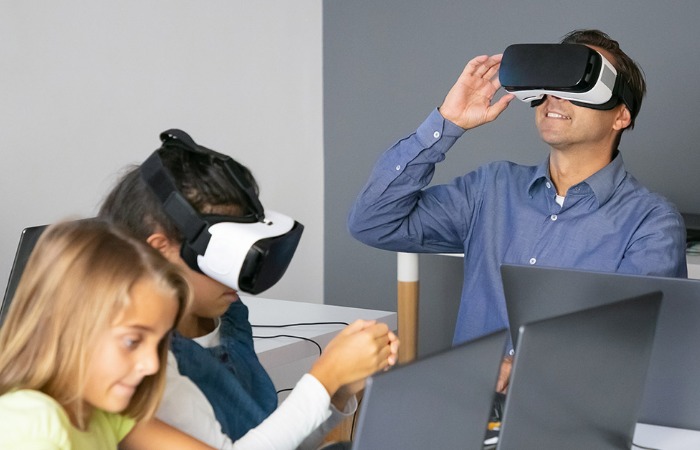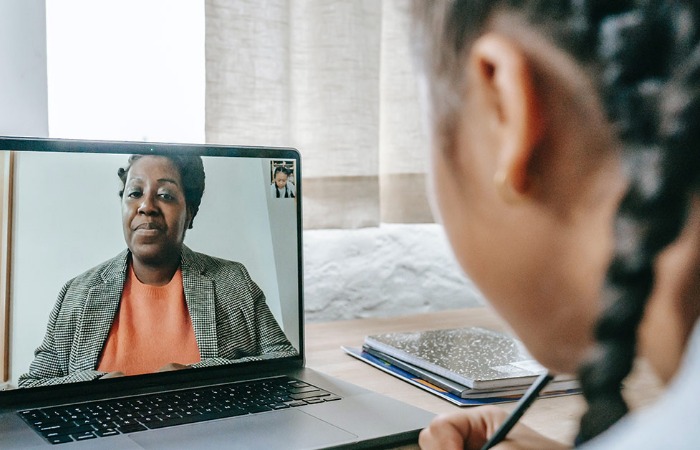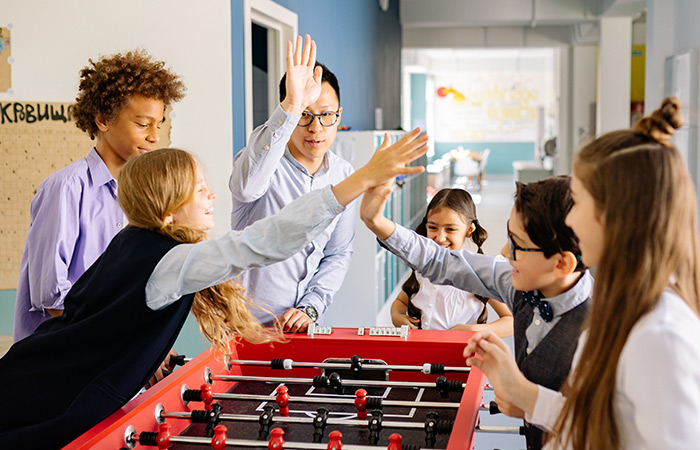Simply put, in order for an individual to become a functional member of their social community, they need to adopt the knowledge and behavioral patterns that their community has accumulated during its existence. It is this process that represents education in a broader sense.
School is the most important educational institution today, but it hasn’t always been like that. In the past, higher education was available only to a small circle of people, while others received knowledge from their parents and transferred it to their children.
From our modern standpoint, now that we are aware of the enormous importance of knowledge and learning, it may seem unbelievable, but the truth is that education as we know today is a fairly young industry. Namely, until the early 19th century, when the first system of primary education was established in Europe and the United States, most people had no formal education whatsoever.
With the rapid growth of cities and industrialization, the amount of knowledge an individual had to possess if they wanted to become a successful member of society grew steadily. In addition to general knowledge, there was also a need for specialized knowledge that required specialized education or vocational training. Today, a literate person must be able to read and write, do arithmetic and possess general knowledge of their environment. Due to the importance of this knowledge, it is nowadays considered compulsory and is acquired exclusively at school, with the exception of countries that accept homeschooling as an alternative to formal school education.
Although education is a process largely associated with the period of formal education (schooling), the truth is somewhat different:
- If we want to, we can continue our education throughout our life, and not just at school.
Namely, in addition to formal education, informal and non-formal education are particularly important and accepted today. They involve development through various courses, and independent learning and research.
So, education is closely related to learning and is an activity that mature individuals practice throughout their lives.
However, due to the growing gap between skills that are sought after in the labor market, and those acquired at school, special emphasis is placed on how to modernize formal education and make it more efficient. This text will first focus on secondary and higher education in the US, and then provide a short description of the most important trends in contemporary education.
Secondary education in the United States
National education in the United States is carefully structured. Although the curricula and systems may differ in parts from state to state, compulsory education includes elementary and secondary education. When it comes to secondary education that covers the period from the 6th through 12th grade (from the age of 11 to the age of 17/18), it consists of two programs:
- middle school (junior high school) and
- high school
A diploma or certificate is awarded upon graduation from high school (meaning the student needs to complete both middle and high school), after which the student may go to college or university.
Middle school
Middle schoolers are required to attend several mandatory courses over the specified number of semesters, such as English, Math, Science, Health and PE, Social Sciences (American History and Government, Geography, World History, and Social Issues). In addition to the required courses, students can also choose between a variety of elective courses, depending on their desires and inclinations, which complement the curriculum and represent a great addition for their future education and professional development.
High school
High school is the final step of compulsory education in the US. It is a very important period in the life and education of every student because this is when they decide on the college/university they want to go to or think about a career in business, industry or another field. Therefore, the curriculum is designed to enable students to choose those courses that will help them achieve their goals, in line with their desires, talents, and inclinations. Depending on the school, their curricula offer different elective courses, and students also get counselors around the 9th grade to help them plan their career and choose courses that will enable them to achieve it. After the 12th grade, students are awarded a high school diploma and they can continue their academic and professional development by starting higher education.
However, the curriculum is only a part of national education in the US. The thing that is especially valued and assessed during enrollment in a college or university, as well as by potential employees are various extracurricular activities, i.e. hobbies. They are carefully designed activities that occur after school, and depending on the school, including team sports, science, eco-friendly activities, music, art, drama and language clubs, school newspaper, and photography.
Good education must be able to respond to future challenges
Unlike other areas of human activity, education has a special task and a great responsibility:
- to prepare children for the future.
In the past, education could implement standardized approaches to train children for existing jobs. With the development of information and communication technologies, where old jobs are disappearing fast and new professions emerge all the time, education has to prepare children for success in an unknown future; the specific task of modern education.
The great responsibility of education lies in the fact that it shapes young minds, and this is especially true for primary/elementary school. Specifically, everything they do in the classroom has the potential to fundamentally impact the lives of students, and consequently, their future. And the future of our civilization depends on their future. This is why education is one of the most important areas of human activity today.
Contemporary educators are making special efforts to create education that will be flexible, efficient, up-to-date and that will prepare students for the challenges of the future.
Good private schools implement modern and proven teaching trends in their teaching and learning process so as to respond to the needs of modern society.
The most significant modern trends in education
STEM
STEM education is based on the idea that students should be educated in four fundamental academic disciplines through an interdisciplinary approach, the four disciplines being:
Science
Technology
Engineering
Mathematics
In place of an outdated approach where these areas were taught separately as individual subjects/courses, the aim here is to have students approach them within the single educational paradigm, thus linking knowledge of all these areas into a whole. That way, students not only acquire the knowledge of all four subjects but also learn to successfully implement it in real life.
Rapid technological development has generated a great demand for experts in the field of science, technology, engineering, and mathematics. However, such experts were hard to find, and the main reason was the inadequacy of the education system, and this is how the STEM concept was developed. Its goal is, on the one hand, to reduce the gap between job supply and demand, and on the other, to educate experts that will be able to respond to complex problems generated by economic development and the society of the 21st century by linking the knowledge of these 4 areas in an innovative way.
There is a great shortage of workers who possess STEM skills on the global labor market, hence the need for such a concept of education.
- The USA alone currently needs over a million STEM workers, and the plan is to train new generations for 3.5 million of STEM jobs by 2025.
Therefore, it is clear that students with STEM education will land jobs more easily in the future. This approach develops their creativity, critical thinking, problem-solving skills, as well as other skills that greatly facilitate their life and work, regardless of their chosen profession.
Future-ready concept
Teaching in the 21st century greatly differs from education received by previous generations: teachers and students use modern devices, such as:
- Internet,
- computer and iPad,
- 3D printers and pens, scanners
- other modern devices that help raise learning to a higher level.
In other words, modern technology has become an integral part of the teaching and learning process.
This is why the Future Ready School concept, which combines quality education and the use of new technologies in education to acquire applicable and functional knowledge, was created.
The current generation of students is introduced to IT devices even before they are able to speak, and Future Ready schools use this fact for educational purposes, addressing children in the language they understand and providing them with quality knowledge, necessary for tackling the needs of the world they live in through the use of educational technology.
In addition to fundamental knowledge, students of Future Ready schools also master the use of information technologies that allow them unhindered access to information and the skills to organize it for the purposes of achieving professional success. So, digital learning plays a significant role in this concept of education.
21st century skills
In modern schools, children acquire valuable skills highly appreciated in academic circles, and sought after by employers. With these skills, students are able to successfully navigate all the challenges of the modern age, and work in different environments, collaborating with different people.
The key five skills for the 21st century taught at school
1. Digital literacy
Unlike the time when we went to school, nowadays, literacy involves the knowledge of new technologies, in addition to being able to read and write. Digital literacy allows an individual to access a huge amount of information, analyze, manage, integrate and evaluate it, but also to create it on their own. This is why it is important that children are introduced to the creative uses, and educational potential of new technologies in a safe way in primary school, under teachers’ guidance.
2. Communication
Communication is the basis of every successful cooperation, but success demands two-way communication, i.e. information has to be followed by feedback. In this modern age, communication has more forms, channels and means than ever before. This is why people need to be capable of exchanging ideas and opinions through various traditional and digital communication channels, but also of skillfully and persuasively shaping what they want to express, either in writing or orally.
3. Teamwork
Teamwork occupies the most important place in the modern academic and business environment. The complex challenges of today, and even more so of the future can be solved only by working together, exchanging ideas and pooling skills. This is why it is crucial to develop children’s communication and teamwork skills, healthy ways to establish communication and exchange ideas and opinions, and correct ways of solving problems and reaching compromise from an early age.
4. Creativity
Creativity is perceived as one of the highest forms of expertise. It involves identifying new connections, relationships and opportunities between known elements, thus reaching new insights that enable progress. Contrary to popular and incorrect opinion that creativity is something a person is born with, we now know that it is acquired and “exercised”. If we want to train children to be successful, we have to nurture and encourage their creativity, encourage different ways of thinking and different worldviews, and develop their ability to find new approaches to problems and tasks.
5. Problem solving and critical thinking
Instead of rote learning formulas, facts and dates, problem solving forces students to use their thinking skills to solve various types of open problems, and that takes the skill of evaluating, filtering and verifying facts, i.e. critical reasoning.
























